For some reason my original thread was closed by the mods. To summarize, the rear passenger side spring included with my ST XTA coilovers broke after less than 3 years and 8000 unsalty miles. I contacted ST and was told that, because I've dared to track-day my car (no mention of such a qualification on the warranty), because the springs, although part of a coilover kit, aren't covered under the coilover warranty, and because they've decided to augment the warranty with a "because I say so" no corrosion clause, the only thing they'd do is cover the shipping on a list price replacement.
I thought about replacing the springs with ST replacements, replacing them with Swift springs, and throwing in the towel and dumping the whole setup. Towel thrown in, ST XTA's off the car, YCW with Swift springs on. Happy me.
I live in Western PA where we do salt the roads. My FiST wears 200 wear tires all the time and doesn't move an inch in the winter. It has never seen an activity salted road. It does see use in early spring where there can be some salt hanging around from the winter but, again, on 200 wear tires, so only on nice days.
I've included some picture of the springs and fronts below. But first, some thoughts about the coilovers as I broke them down. I noticed most of this when I installed them but I thought that I was buying the best of the rest parts so I guessed that they knew better than I. I've taken apart a fair share of coilovers and there were a couple of things that caught my attention:
I just installed a set of YCW Reference coilovers and the quality is miles better. The YCW entry-level coilovers are cheaper and better than the ST XTA's (but I think that they aren't adjustable).
These are getting cleaned up, wire wheeled, painted with etching primer, loaded with Swift springs and aluminum hardware, and put onto my son's FiST..., with a wary eye.
Broken coil (left):
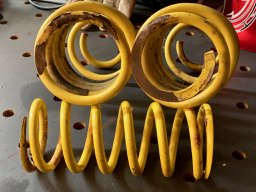
Coating flaking and rust coming through:
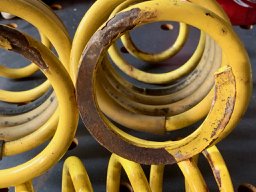
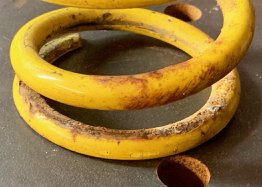
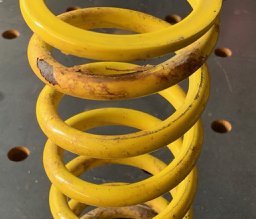
Failing finish on body:
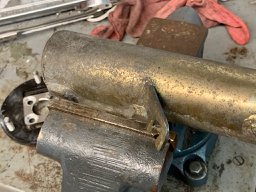
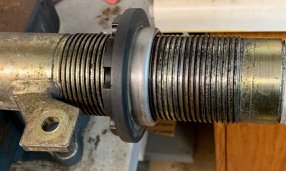
I thought about replacing the springs with ST replacements, replacing them with Swift springs, and throwing in the towel and dumping the whole setup. Towel thrown in, ST XTA's off the car, YCW with Swift springs on. Happy me.
I live in Western PA where we do salt the roads. My FiST wears 200 wear tires all the time and doesn't move an inch in the winter. It has never seen an activity salted road. It does see use in early spring where there can be some salt hanging around from the winter but, again, on 200 wear tires, so only on nice days.
I've included some picture of the springs and fronts below. But first, some thoughts about the coilovers as I broke them down. I noticed most of this when I installed them but I thought that I was buying the best of the rest parts so I guessed that they knew better than I. I've taken apart a fair share of coilovers and there were a couple of things that caught my attention:
- Plastic lower perches. Instead of the aluminum lower perches that I'm used to, there are plastic, all the way to the threads. They are cast on a thin steel core, but everything that touches a spring or the threaded body is plastic.
- Set screw instead of locking ring. After you set preload you're supposed to set the ring with a set screw into the body rather than backing up the bottom of the perch with a locking ring. No likey.
- Crappy finish on the body. It looks like they've been anodized but they're steel so I don't know what the coating is (zinc plating, they claim). At any rate, it did not hold up. In fact, it adds a rough finish that really hangs onto the road grime. It took a ridiculous amount of PB Blaster to clean up the threaded portion of the body.
- Meh hardware. Like I said, I've been through a bunch of coilovers. These felt cheap. The top nut was too tall. Too much plastic in the spring stack (they have helpers). The uniball was super stiff. The hats feel cheap.
- Decent dampeners. Other than not having a ride-height adjustment (you have to play with the spring pre-load), the dampeners feel fine. I believe that these are the same as they use on the 1-way adjustable KW coilovers but the KW's get a better coating. The threaded top of the dampener itself seems to bottom on the body to there's a lovely grime and grease catch rather than a smooth transition; you can see that on the right edge of one of the photos. The welds are nice.
I just installed a set of YCW Reference coilovers and the quality is miles better. The YCW entry-level coilovers are cheaper and better than the ST XTA's (but I think that they aren't adjustable).
These are getting cleaned up, wire wheeled, painted with etching primer, loaded with Swift springs and aluminum hardware, and put onto my son's FiST..., with a wary eye.
Broken coil (left):

Coating flaking and rust coming through:



Failing finish on body:


